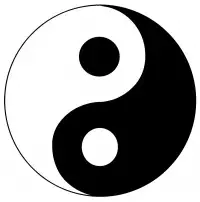YinYang as Problem-solving Methodology
YinYang, as expressed by the Taijitu symbol, has helped me solve many problems. The two major components represent the two major opposing forces in any event. The smaller part of each in the other represents the interplay between the two.
I have extracted five principles from YinYang that have helped me. In short, optimal solutions will:
- Have opposing forces (i.e. ideas, emotions, things) at work
- Not choose one force over the other
- Balance and integrate the two forces
- Have one force as dominant and the other supportive
- Vary by situation
For example, let’s consider the problem of how much to water a plant. Two forces exist, dryness and wetness (#1). If we choose dryness over wetness by never watering the plant, it will die. If we choose wetness over dryness by constantly watering the plant, the plant will die (#2). Thus, we need to integrate the two and find the right balance between watering and drying (#3). In this balance, the plant’s soil will be mainly dry or wet (#4). This balance varies by plant (#5, i.e. cacti versus willows).
In business, we often view these as tradeoffs such as processes versus flexibility, positive versus negative reinforcements, best practices versus differentiation, focus versus situational awareness, change versus resistance, profits versus investments, and glass half-full versus half-empty. However, tradeoffs encourage the temptation to choose one over the other; it’s really about integrating the two (#4).
Many times, it’s difficult to identify the opposing force. So, I ask myself this question:
If I take an obvious solution to the extreme, what would happen?
For example, too much process makes everything bureaucratic. Too much importance on profits retards investments. Once accomplished, we can begin balancing the two to arrive at an optimal solution for the situation at hand.


